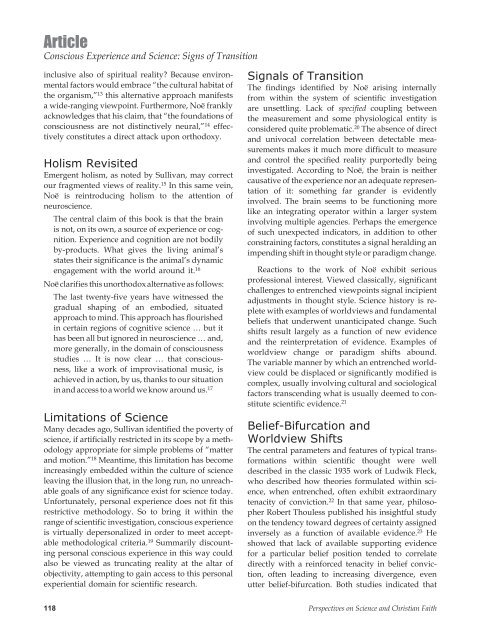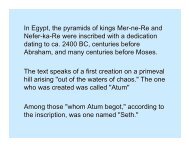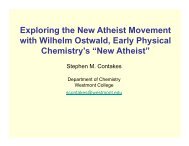ASA BLOGS - Start
ASA BLOGS - Start
ASA BLOGS - Start
Create successful ePaper yourself
Turn your PDF publications into a flip-book with our unique Google optimized e-Paper software.
Article<br />
Conscious Experience and Science: Signs of Transition<br />
inclusive also of spiritual reality? Because environmental<br />
factors would embrace “the cultural habitat of<br />
the organism,” 13 this alternative approach manifests<br />
a wide-ranging viewpoint. Furthermore, Noë frankly<br />
acknowledges that his claim, that “the foundations of<br />
consciousness are not distinctively neural,” 14 effectively<br />
constitutes a direct attack upon orthodoxy.<br />
Holism Revisited<br />
Emergent holism, as noted by Sullivan, may correct<br />
our fragmented views of reality. 15 In this same vein,<br />
Noë is reintroducing holism to the attention of<br />
neuroscience.<br />
The central claim of this book is that the brain<br />
is not, on its own, a source of experience or cognition.<br />
Experience and cognition are not bodily<br />
by-products. What gives the living animal’s<br />
states their significance is the animal’s dynamic<br />
engagement with the world around it. 16<br />
Noë clarifies this unorthodox alternative as follows:<br />
The last twenty-five years have witnessed the<br />
gradual shaping of an embodied, situated<br />
approach to mind. This approach has flourished<br />
in certain regions of cognitive science … but it<br />
has been all but ignored in neuroscience … and,<br />
more generally, in the domain of consciousness<br />
studies … It is now clear … that consciousness,<br />
like a work of improvisational music, is<br />
achieved in action, by us, thanks to our situation<br />
in and access to a world we know around us. 17<br />
Limitations of Science<br />
Many decades ago, Sullivan identified the poverty of<br />
science, if artificially restricted in its scope by a methodology<br />
appropriate for simple problems of “matter<br />
and motion.” 18 Meantime, this limitation has become<br />
increasingly embedded within the culture of science<br />
leaving the illusion that, in the long run, no unreachable<br />
goals of any significance exist for science today.<br />
Unfortunately, personal experience does not fit this<br />
restrictive methodology. So to bring it within the<br />
range of scientific investigation, conscious experience<br />
is virtually depersonalized in order to meet acceptable<br />
methodological criteria. 19 Summarily discounting<br />
personal conscious experience in this way could<br />
also be viewed as truncating reality at the altar of<br />
objectivity, attempting to gain access to this personal<br />
experiential domain for scientific research.<br />
Signals of Transition<br />
The findings identified by Noë arising internally<br />
from within the system of scientific investigation<br />
are unsettling. Lack of specified coupling between<br />
the measurement and some physiological entity is<br />
considered quite problematic. 20 The absence of direct<br />
and univocal correlation between detectable measurements<br />
makes it much more difficult to measure<br />
and control the specified reality purportedly being<br />
investigated. According to Noë, the brain is neither<br />
causative of the experience nor an adequate representation<br />
of it: something far grander is evidently<br />
involved. The brain seems to be functioning more<br />
like an integrating operator within a larger system<br />
involving multiple agencies. Perhaps the emergence<br />
of such unexpected indicators, in addition to other<br />
constraining factors, constitutes a signal heralding an<br />
impending shift in thought style or paradigm change.<br />
Reactions to the work of Noë exhibit serious<br />
professional interest. Viewed classically, significant<br />
challenges to entrenched viewpoints signal incipient<br />
adjustments in thought style. Science history is replete<br />
with examples of worldviews and fundamental<br />
beliefs that underwent unanticipated change. Such<br />
shifts result largely as a function of new evidence<br />
and the reinterpretation of evidence. Examples of<br />
worldview change or paradigm shifts abound.<br />
The variable manner by which an entrenched worldview<br />
could be displaced or significantly modified is<br />
complex, usually involving cultural and sociological<br />
factors transcending what is usually deemed to constitute<br />
scientific evidence. 21<br />
Belief-Bifurcation and<br />
Worldview Shifts<br />
The central parameters and features of typical transformations<br />
within scientific thought were well<br />
described in the classic 1935 work of Ludwik Fleck,<br />
who described how theories formulated within science,<br />
when entrenched, often exhibit extraordinary<br />
tenacity of conviction. 22 In that same year, philosopher<br />
Robert Thouless published his insightful study<br />
on the tendency toward degrees of certainty assigned<br />
inversely as a function of available evidence. 23 He<br />
showed that lack of available supporting evidence<br />
for a particular belief position tended to correlate<br />
directly with a reinforced tenacity in belief conviction,<br />
often leading to increasing divergence, even<br />
utter belief-bifurcation. Both studies indicated that<br />
118 Perspectives on Science and Christian Faith




